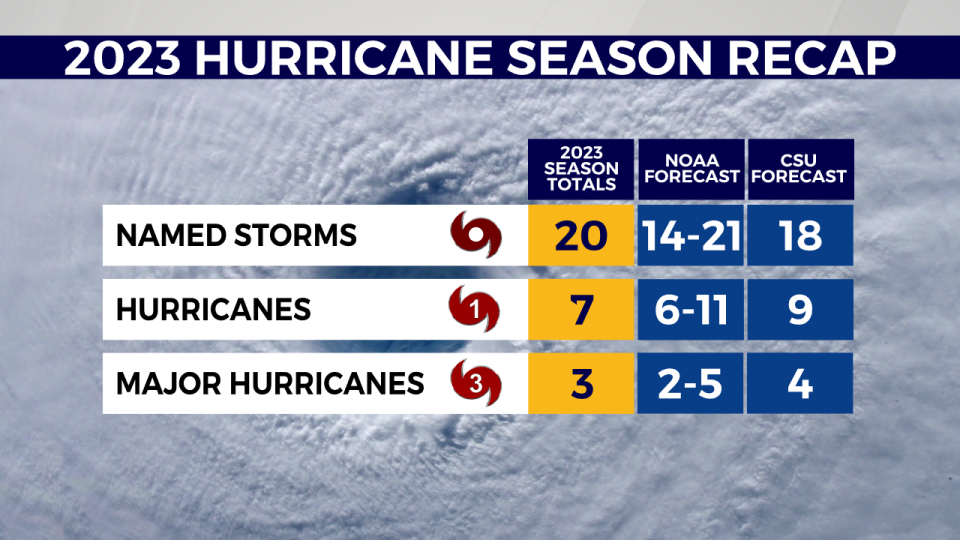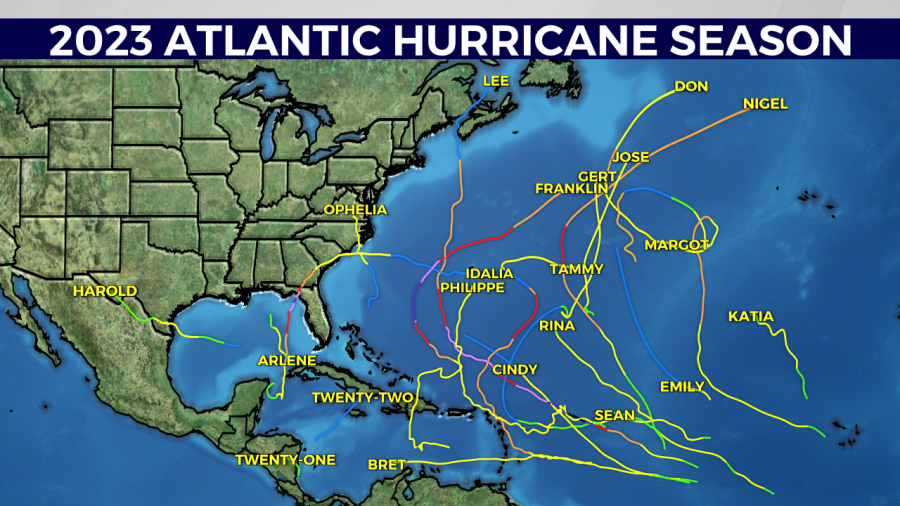2023 Atlantic hurricane season ends with 20 named storms, few U.S. landfalls

NEW ORLEANS (WGNO) — The 2023 Atlantic hurricane season, officially ending on Nov. 30, has been one of above-normal activity, marked by several impactful storms and unique weather patterns.
With a total of 20 named storms, this season ranks fourth since 1950 in terms of storm numbers. Seven of these storms became hurricanes, and three reached major hurricane status. For comparison, an average season typically sees 14 named storms, seven hurricanes, and three major hurricanes.
The 2023 Atlantic seasonal activity fell within the NOAA Climate Prediction Center’s predicted ranges for named storms and hurricanes in the August updated outlook. It was also close to the predictions made by Colorado State University.
This year’s hurricane season was defined by record-warm Atlantic sea surface temperatures and the presence of a strong El Niño.
“The Atlantic basin produced the most named storms of any El Nino influenced year in the modern record,” said Matthew Rosencrans, lead hurricane forecaster at NOAA’s Climate Prediction Center. “The record-warm ocean temperatures in the Atlantic provided a strong counterbalance to the traditional El Nino impacts.”
Landfalling Events
The 2023 hurricane season left its mark with several impactful landfalling storms, each leaving a distinct trail of destruction and prompting widespread alerts and precautions.
Hurricane Idalia Strikes Florida: Hurricane Idalia stands out as the sole U.S. landfalling hurricane in 2023. On August 30, the category-3 hurricane hit near Keaton Beach, Florida. Its arrival brought a storm surge of 7 to 12 feet, inundating coastal areas and triggering extensive rainfall flooding across Florida and the southeastern U.S.
Tropical Storm Ophelia’s Impact on North Carolina: Emerald Isle, North Carolina, faced the fury of Tropical Storm Ophelia on September 23. Packing winds at 70 mph, Ophelia’s impacts included widespread heavy rainfall, gusty winds, and significant river and storm surge flooding in eastern North Carolina.
Hurricane Lee’s Reach to Nova Scotia: After transitioning from a hurricane to a post-tropical cyclone, Lee made its landfall in Nova Scotia, Canada, on September 16. Lee’s swells created high surf and rip currents along the entire U.S. Atlantic coast. The storm’s strong winds, with gusts similar to those of a hurricane, caused extensive power outages in Maine and parts of Canada.
Technological Advancements
This season, NOAA’s innovative Hurricane Analysis and Forecast System (HAFS) played a pivotal role in enhancing intensity predictions for storms.
The system accurately forecasted Hurricane Idalia’s intensity as a major hurricane impacting Florida’s coast as early as August 28. The agency says this early warning facilitated better preparedness, preventing storm surge fatalities despite inundation reaching up to 12 feet in certain areas.
Extending the National Hurricane Center’s tropical weather outlook product from five to seven days also proved instrumental, according to NOAA. Emergency managers gained additional time to organize and deploy resources ahead of storms, enhancing overall readiness and response strategies.
Staying Prepared
As the curtains draw on the 2023 hurricane season, Michael Brennan, Ph.D., Director of NOAA’s National Hurricane Center, reflects on the season’s impact, emphasizing the need for comprehensive safety plans, regardless of coastal or inland locations.
“This active hurricane season witnessed hazards extending well beyond landfall locations,” said Brennan. “It’s crucial to have a robust safety plan in place, regardless of where you reside.”
NOAA’s Climate Prediction Center will issue its 2024 hurricane seasonal outlook in May 2024. The Atlantic hurricane season officially begins June 1.
Stay updated with the latest news, weather, and sports by downloading the WGNO app on the Apple or Google Play store and subscribing to the WGNO newsletter.
Latest Posts
WATCH: Young whale leaps out of Seattle bay, dazzling onlookers
Jets strike targets in Gaza as Israel resumes offensive, warns of attacks to come in south
The Memo: Trump’s blast at MSNBC — empty threat or real danger?
For the latest news, weather, sports, and streaming video, head to WGNO.



